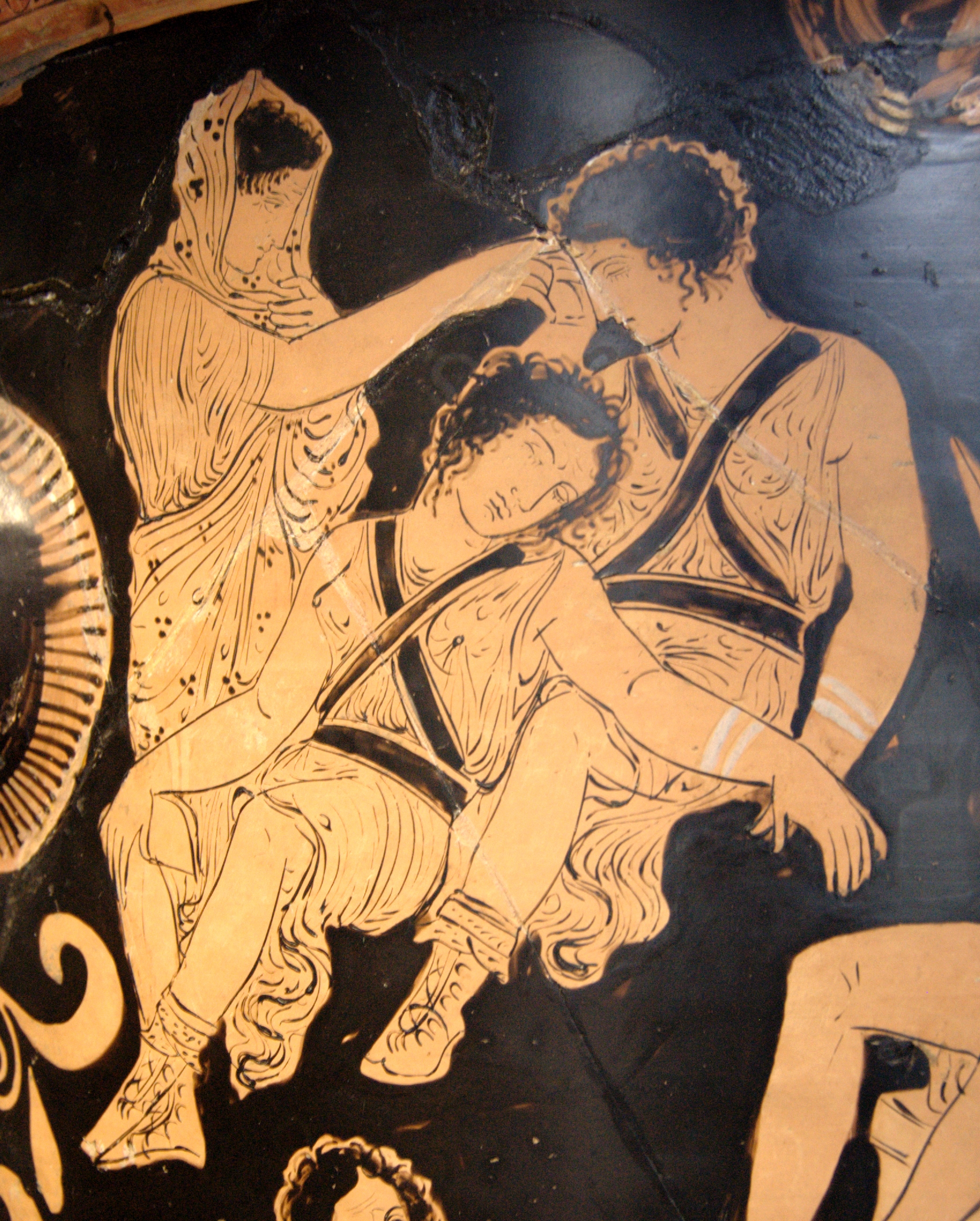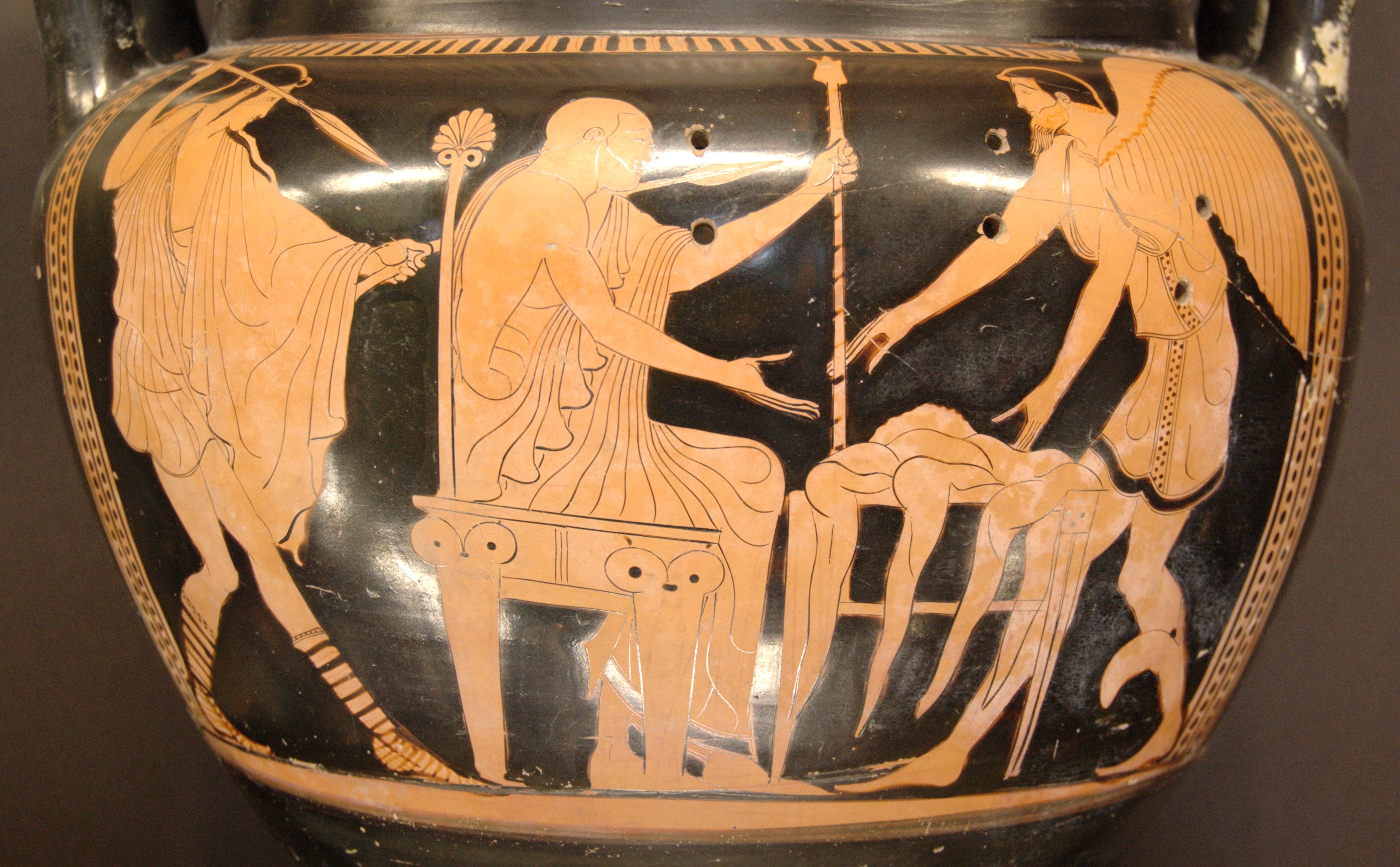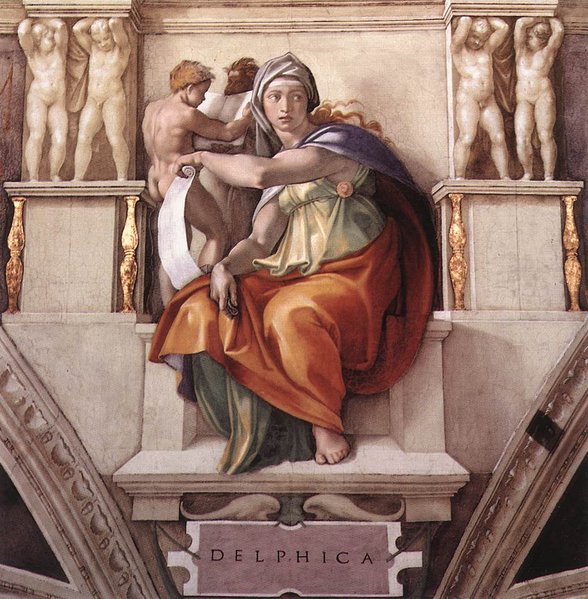|
Harpy
In Greek mythology and Roman mythology, a harpy (plural harpies, , ; lat, harpȳia) is a half-human and half-bird personification of storm winds. They feature in Homeric poems. Descriptions They were generally depicted as birds with the heads of maidens, faces pale with hunger and long claws on their hands. Roman and Byzantine writers detailed their ugliness. Pottery art depicting the harpies featured beautiful women with wings. Ovid described them as human-vultures. Hesiod To Hesiod, they were imagined as fair-locked and winged maidens, who flew as fast as the wind. Aeschylus But even as early as the time of Aeschylus, they are described as ugly creatures with wings, and later writers carry their notions of the harpies so far as to represent them as most disgusting monsters. The Pythian priestess of Apollo recounted the appearance of the harpies in the following lines: Virgil Hyginus Functions and abodes The harpies seem originally to have been wind spirits (perso ... [...More Info...] [...Related Items...] OR: [Wikipedia] [Google] [Baidu] |
Legendary Creature
A legendary creature (also mythical or mythological creature) is a type of fictional entity, typically a hybrid, that has not been proven and that is described in folklore (including myths and legends), but may be featured in historical accounts before modernity. In the classical era, monstrous creatures such as the Cyclops and the Minotaur appear in heroic tales for the protagonist to destroy. Other creatures, such as the unicorn, were claimed in accounts of natural history by various scholars of antiquity. Some legendary creatures have their origin in traditional mythology and were believed to be real creatures, for example dragons, griffins, and unicorns. Others were based on real encounters, originating in garbled accounts of travellers' tales, such as the Vegetable Lamb of Tartary, which supposedly grew tethered to the earth. Creatures A variety of mythical animals appear in the art and stories of the classical era. For example, in the ''Odyssey'', monstrous ... [...More Info...] [...Related Items...] OR: [Wikipedia] [Google] [Baidu] |
Hybrid (mythology)
Hybrid beasts are creatures composed of parts from different animals, including humans, appearing in the folklore of a variety of cultures as legendary creatures. In burial sites Remains similar to those of mythological hybrids have been found in burial sites discovered by archaeologists. Known combinations include horse-cows, sheep-cows, and a six-legged sheep. The skeletons were formed by ancient peoples who joined together body parts from animal carcasses of different species. The practice is believed to have been done as an offering to their gods. Description These forms' motifs appear across cultures in many mythologies around the world. Such hybrids can be classified as partly human hybrids (such as mermaids or centaurs) or non-human hybrids combining two or more non-human animal species (such as the griffin or the chimera). Hybrids often originate as zoomorphic deities who, over time, are given an anthropomorphic aspect. Paleolithic Partly human hybrids appear in petro ... [...More Info...] [...Related Items...] OR: [Wikipedia] [Google] [Baidu] |
Pandareus
In Greek mythology, Pandareus () was the son of Merops and a nymph. His residence was given as either EphesusAntoninus Liberalis11as cited in Boeus' ''Ornithogonia'' or Miletus. Pausanias, 10.30.2 Mythology Pandareus was said to have been favored by Demeter, who conferred upon him the benefit of never suffering from indigestion, however much food he should eat. At the request of his impious friend, Tantalus, Pandareus stole a golden dog from a temple to Zeus on Crete (the dog had guarded Zeus during his infancy by the will of Rhea). According to various sources, he was either turned to stone or fled to Sicily, where he perished together with his wife Harmothoë. Pandareus was the father of Aedon (wife of Zethus), Chelidonis, Cleodora (or Cleothera) and Merope; according to Pausanias, the last two were called Cameiro and Clytia. After the death of their parents, Aphrodite took care of Cleodora and Merope, Hera taught them to be proper women, and Athena made them accom ... [...More Info...] [...Related Items...] OR: [Wikipedia] [Google] [Baidu] |
Earth
Earth is the third planet from the Sun and the only astronomical object known to harbor life. While large volumes of water can be found throughout the Solar System, only Earth sustains liquid surface water. About 71% of Earth's surface is made up of the ocean, dwarfing Earth's polar ice, lakes, and rivers. The remaining 29% of Earth's surface is land, consisting of continents and islands. Earth's surface layer is formed of several slowly moving tectonic plates, which interact to produce mountain ranges, volcanoes, and earthquakes. Earth's liquid outer core generates the magnetic field that shapes the magnetosphere of the Earth, deflecting destructive solar winds. The atmosphere of the Earth consists mostly of nitrogen and oxygen. Greenhouse gases in the atmosphere like carbon dioxide (CO2) trap a part of the energy from the Sun close to the surface. Water vapor is widely present in the atmosphere and forms clouds that cover most of the planet. More sola ... [...More Info...] [...Related Items...] OR: [Wikipedia] [Google] [Baidu] |
Erinyes
The Erinyes ( ; sing. Erinys ; grc, Ἐρινύες, pl. of ), also known as the Furies, and the Eumenides, were female chthonic deities of vengeance in ancient Greek religion and mythology. A formulaic oath in the '' Iliad'' invokes them as "the Erinyes, that under earth take vengeance on men, whosoever hath sworn a false oath". Walter Burkert suggests that they are "an embodiment of the act of self-cursing contained in the oath". They correspond to the Dirae in Roman mythology. The Roman writer Maurus Servius Honoratus wrote (ca. 400 AD) that they are called "Eumenides" in hell, "Furiae" on Earth, and "Dirae" in heaven. Erinyes are akin to some other Greek deities, called Poenai. According to Hesiod's '' Theogony'', when the Titan Cronus castrated his father, Uranus, and threw his genitalia into the sea, the Erinyes (along with the Giants and the Meliae) emerged from the drops of blood which fell on the Earth (Gaia), while Aphrodite was born from the crests of se ... [...More Info...] [...Related Items...] OR: [Wikipedia] [Google] [Baidu] |
Adrian Room
Adrian Richard West Room (27 September 1933, Melksham – 6 November 2010, Stamford, Lincolnshire)''Contemporary Authors Online'', Gale, 2002; accessed 20 May 2013. was a British toponymist and onomastician, a Fellow of the Royal Geographical Society and a prolific author of reference works relating primarily to the origins of word and place-names. Between 1952 and 1979, Room served in the Royal Naval Reserve, Special Branch, retiring as a Lieutenant Commander. Before becoming a full-time author, he was employed at King's College School, Cambridge, where he taught modern languages and was a senior house master. He later, until 1984, worked as a senior lecturer in Russian for the Ministry of Defence. Selected publications *''Place-Names of the World''. London: Routledge & Kegan Paul, 1974. *''Place-name changes since 1900: A world gazetteer''. London: Routledge & Kegan Paul, 1980. *''Naming Names: Stories of Pseudonyms and Name Changes with a Who's Who''. London: Routledge ... [...More Info...] [...Related Items...] OR: [Wikipedia] [Google] [Baidu] |
Mirror With Figure Of A Harpy, 11-12th Century, Termez, Uzbekistan
A mirror or looking glass is an object that reflects an image. Light that bounces off a mirror will show an image of whatever is in front of it, when focused through the lens of the eye or a camera. Mirrors reverse the direction of the image in an equal yet opposite angle from which the light shines upon it. This allows the viewer to see themselves or objects behind them, or even objects that are at an angle from them but out of their field of view, such as around a corner. Natural mirrors have existed since prehistoric times, such as the surface of water, but people have been manufacturing mirrors out of a variety of materials for thousands of years, like stone, metals, and glass. In modern mirrors, metals like silver or aluminium are often used due to their high reflectivity, applied as a thin coating on glass because of its naturally smooth and very hard surface. A mirror is a wave reflector. Light consists of waves, and when light waves reflect from the flat surface of ... [...More Info...] [...Related Items...] OR: [Wikipedia] [Google] [Baidu] |
Phineus
In Greek mythology, Phineus (; Ancient Greek: Φινεύς, ) or Phineas, was a king of Salmydessus in Thrace and seer, who appears in accounts of the Argonauts' voyage. Some accounts make him a king in PaphlagoniaScholia on Apollonius of Rhodes, 2.178, 237; Scholia ''ad eund'' 2.177; Eustathius ad Homer, ''Iliad'2.851 ad Dionysius Periegetes, 787; Stephanus of Byzantium, s.v.; Constantine Porphyrogennetos, ''De thematibus'' 1.7; William Smith, '' Dictionary of Greek and Roman Geography'' s.v. Paphlagonia' or in Arcadia. Family Several different versions of Phineus's parentage were presented in ancient texts. According to Apollonius of Rhodes, he was a son of Agenor, but the '' Bibliotheca'' says that other authors named his father as Poseidon (who is the father of Agenor).Apollodorus1.9.21/ref> The Hesiodic ''Catalogue of Women'', on the other hand, reported that Phineus was the son of Phoenix and Cassiopeia. His first wife was Cleopatra, daughter of Boreas and Orei ... [...More Info...] [...Related Items...] OR: [Wikipedia] [Google] [Baidu] |
Apollo
Apollo, grc, Ἀπόλλωνος, Apóllōnos, label=genitive , ; , grc-dor, Ἀπέλλων, Apéllōn, ; grc, Ἀπείλων, Apeílōn, label=Arcadocypriot Greek, ; grc-aeo, Ἄπλουν, Áploun, la, Apollō, la, Apollinis, label=genitive, , ; , is one of the Twelve Olympians, Olympian deities in Ancient Greek religion, classical Greek and Ancient Roman religion, Roman religion and Greek mythology, Greek and Roman mythology. The national divinity of the Greeks, Apollo has been recognized as a god of archery, music and dance, truth and prophecy, healing and diseases, the Sun and light, poetry, and more. One of the most important and complex of the Greek gods, he is the son of Zeus and Leto, and the twin brother of Artemis, goddess of the hunt. Seen as the most beautiful god and the ideal of the ''kouros'' (ephebe, or a beardless, athletic youth), Apollo is considered to be the most Greek of all the gods. Apollo is known in Greek-influenced Etruscan mythology as ' ... [...More Info...] [...Related Items...] OR: [Wikipedia] [Google] [Baidu] |
Sibyl
The sibyls (, singular ) were prophetesses or oracles in Ancient Greece. The sibyls prophesied at holy sites. A sibyl at Delphi has been dated to as early as the eleventh century BC by PausaniasPausanias 10.12.1 when he described local traditions in his writings from the second century AD. At first, there appears to have been only a single sibyl. By the fourth century BC, there appear to have been at least three more, Phrygian, Erythraean, and Hellespontine. By the first century BC, there were at least ten sibyls, located in Greece, Italy, the Levant, and Asia Minor. History The English word ''sibyl'' ( or ) is from Middle English, via the Old French and the Latin from the ancient Greek (). Varro derived the name from an Aeolic ''sioboulla'', the equivalent of Attic '' theobule'' ("divine counsel"). This etymology is still widely accepted, although there have been alternative proposals in nineteenth-century philology suggesting Old Italic or Semitic derivation. The ... [...More Info...] [...Related Items...] OR: [Wikipedia] [Google] [Baidu] |
Aeschylus
Aeschylus (, ; grc-gre, Αἰσχύλος ; c. 525/524 – c. 456/455 BC) was an ancient Greek tragedian, and is often described as the father of tragedy. Academic knowledge of the genre begins with his work, and understanding of earlier Greek tragedy is largely based on inferences made from reading his surviving plays. According to Aristotle, he expanded the number of characters in the theatre and allowed conflict among them. Formerly, characters interacted only with the chorus.The remnant of a commemorative inscription, dated to the 3rd century BC, lists four, possibly eight, dramatic poets (probably including Choerilus, Phrynichus, and Pratinas) who had won tragic victories at the Dionysia before Aeschylus had. Thespis was traditionally regarded the inventor of tragedy. According to another tradition, tragedy was established in Athens in the late 530s BC, but that may simply reflect an absence of records. Major innovations in dramatic form, credited to Aeschylus by Aristot ... [...More Info...] [...Related Items...] OR: [Wikipedia] [Google] [Baidu] |







